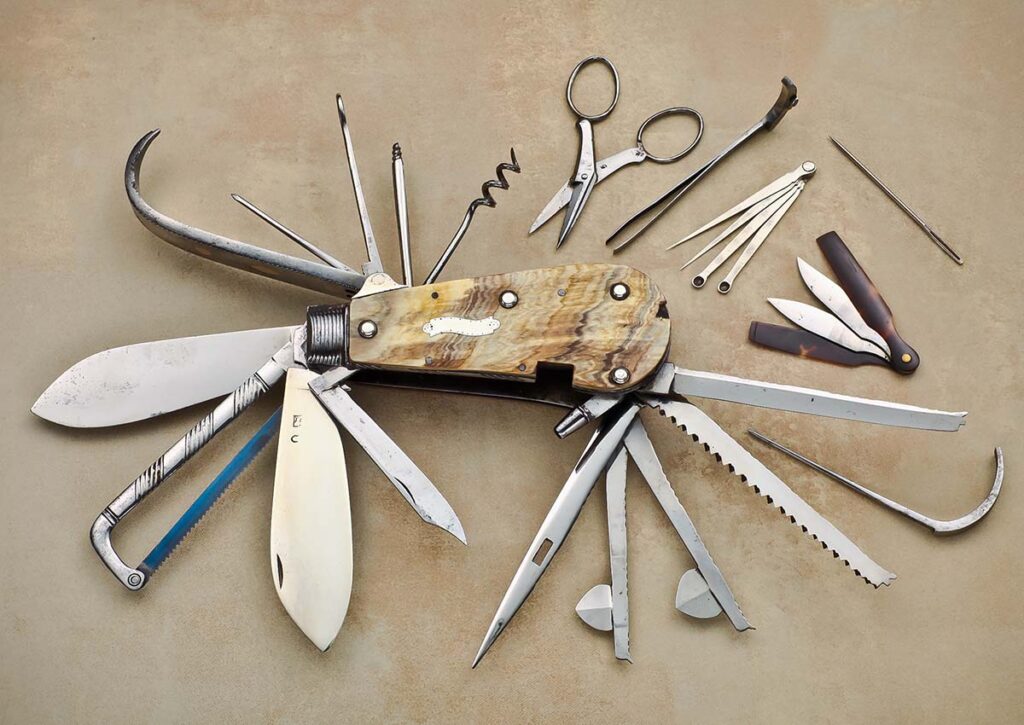The simple pockeknife still holds its own after all these years.
Whether a four-figure custom slip joint, an inexpensive factory keychain knife or what you, if it’s a knife that carries in a pocket, it is a pocketknife. Pocketknives have a colorful heritage, one that not only represents some of the best cutting tools mankind has ever produced but at times has been on the right side of history as well.
Some of the first known folding knife designs date to the Roman era, if not earlier. However, the fact many Romans wore togas or tunics—most if not all of which were pocketless—precluded most of them from carrying pocketknives. If not, Brutus and his co-conspirators likely would’ve used pocketknives instead of the daggers they employed to dispatch Julius Caesar. Daggers suffered centuries of bans afterward and continue to be targeted by misguided anti-knifers to this day. If pocketknives could talk, the feeling here is they would probably thank the pocketless togas and/or tunics.
Fast forward to Sheffield, England, where the Masters of the London Cutlers Guild listed members as early as the 16th century. The pocketknives made in Sheffield for centuries remain some of the most remarkable specimens ever. Meanwhile, a number of the Sheffield makers came to America in the 19th century. Their influence helped jump start the U.S. pocketknife industry in the 1800s and aided in revolutionizing it in the 20th century. From the barlow to the stockman and scores of other patterns, many Americans carried pocketknives daily for almost every chore under the sun. That tradition was passed down from generation to generation and became an American institution.
The most famous of Americans carried pocketknives, including presidents such as George Washington and Abraham Lincoln. Acting icon John Wayne used pocketknives in some of his movie roles, including as Jacob McCandles in Big Jake and Capt. Nathan Brittles in She Wore a Yellow Ribbon, to name but two. Even Boy Scouts and Girl Scouts had pocketknives made expressly for them, with the latter holding the distinction of being among the first if not the first sporting knives designed expressly for the feminine gender.
Closer to home, the argument can be made there would be no BLADE Show without pocketknives, as the two men who created the show—BLADE Magazine Cutlery Hall-Of-Fame® members Bruce Voyles and Jim Parker—parlayed their love of traditional pocketknives into long cutlery careers that helped make knife collecting something worth doing. Jim, Bruce and others were among many in the South who celebrated the early trading of pocketknives on the courthouse steps of local communities, and eventually helped capture the imagination of knife enthusiasts everywhere.
Pocketknives are not just a British/American phenomenon but a worldwide one. The navaja of Spain, the Opinel of France, German models of many stripes, and perhaps the most famous pocketknife of all, the Swiss Army knife (SAK) of Switzerland, are but four examples.
Two of the leading knife genres of the past half century, tactical folders and EDCs, owe much of their appeal to being pocketknives. In fact, pocketknives have provided the platform for the introduction of some of the most influential advancements in cutlery, including assorted opening and locking mechanisms, hi-tech materials and knifemaking methods, and much more.
Give it up for pocketknives. Without them, cutlery would be nowhere near—in fact, about half—the vibrant worldwide industry it is today.
More On Pocketknives:
- Kershaw Blur Review: Focusing On The EDC Classic
- The Challenge Of Creating Lockback Whittlers
- Kershaw Leek Review: Not Your Garden-Variety EDC Knife
- Spyderco Paramilitary 2 Review: Still A Cut Above The Rest
BLADE’s annual Knife Guide Issue features the newest knives and sharpeners, plus knife and axe reviews, knife sheaths, kit knives and a Knife Industry Directory.Get your FREE digital PDF instant download of the annual Knife Guide. No, really! We will email it to you right now when you subscribe to the BLADE email newsletter.
Click Here to Subscribe and get your free digital 2025 Knife Guide!
